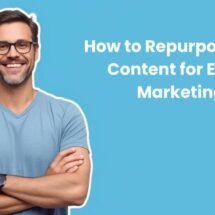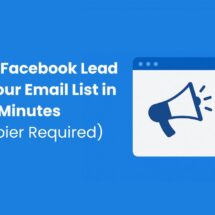How to Start a Newsletter: A Step-by-Step Guide for Beginners
By Sean Tinney May 22, 2025
Ever felt like your great ideas, business updates, or stories vanish into the social media void? Imagine reaching your audience directly, with no algorithms dialing down your message. That’s the power of starting a newsletter. Whether you’re looking to build a community, drive sales, or simply share your passion, a newsletter is your most dependable digital megaphone.
If you’re wondering how to start a newsletter, the process is easier (and more affordable) than you might think. You can start a newsletter for free, learn the steps in under 10 minutes, and launch even if you have zero technical experience. Here’s everything you need to know to get started today—including the essential tools, best practices, and real-world advice to grow your subscriber list.
Why Start a Newsletter? (And Why Now?)
Newsletters aren’t a trend—they’re a tried-and-true tool. Unlike fleeting social posts, emails land directly in your subscriber’s inbox, making them far more likely to be seen. According to Statista, over 400 billion are sent and received per day. Businesses and creators who start email newsletters enjoy higher engagement than nearly any other channel. In short: if you want to own your audience, a newsletter is a must.
How Do You Start a Newsletter? Quick Checklist
Ready to jump in? Here are the essential steps for how to start newsletter quickly and effectively:
- Define your newsletter’s purpose
- Choose a reliable (and if possible, free) email platform
- Build your first subscriber list
- Design your welcome email
- Plan your content and set a schedule
- Promote your signup form
Let’s walk through each step together, using real examples and simple actions you can take right now.
1. Define Your Newsletter’s Purpose and Audience
Before you think about tools or templates, ask yourself: What value will your newsletter give subscribers? Who will benefit most from it?
Your purpose could be as broad as “share industry news weekly” or as personal as “send art project updates to friends.” For example, a yoga instructor might share beginner pose tutorials and wellness tips. A local artist might show behind-the-scenes photos or announce new exhibits. Define your target reader and how your emails will make their lives better.
Tip: Write a one-sentence mission for your newsletter. This will guide the tone, frequency, and content of every edition.
2. Choose Your Newsletter Platform (How to Start a Newsletter for Free)
Modern, easy-to-use tools make it simple to start a newsletter for free. Look for an email marketing platform that offers:
- User-friendly sign-up forms
- Drag-and-drop email editors
- Customizable templates
- List management
- Free plan options for small subscriber lists
AWeber’s plan covers all the basics, including an AI Newsletter Assistant, unlimited emails, and advanced automation tools to help you grow with confidence. Choose a platform that fits your technical comfort level and will scale as your audience grows.
3. Build (and Name) Your First Subscriber List
Your subscriber list is the heartbeat of your newsletter. Start by creating a list—think of it as your private address book. Naming your list helps you stay organized (example: “Monthly Wellness Tips”). Even if you don’t have any subscribers yet, this step sets the stage for growth.
For details on growing your first subscriber list, see how to build an email list from scratch.
4. Design an Irresistible Signup Form
To grow your newsletter, you need an opt-in form people can use to subscribe. Place your signup form in places your audience already visits: your website, blog, portfolio, or even your social media bio. Keep the form simple—ask only for the information you truly need (often just an email address and first name).
Effective signup forms use clear, benefit-driven language. For example: “Get weekly book recommendations and reading tips—no spam, ever.” Bonus tip: Adding a short privacy statement boosts trust. Subscribers are more likely to join lists that clearly state how their info will be used.
5. Write and Schedule Your Welcome Email
Your welcome email is your first impression. It sets expectations and builds excitement. Here’s a quick template:
“Hi [Name], thanks for subscribing to [Newsletter Name]! Here’s what to expect, how to get the most from these emails, and where to reach me with questions. Can’t wait to connect!”
Most email platforms let you set up an automated welcome email, so every new subscriber is greeted instantly. For guidance, read these welcome email examples and best practices.
6. Plan Your Newsletter Content
Wondering what to include in your newsletter? Content depends on your audience and goal. Common approaches:
- Educational emails—Teach subscribers something new (e.g., a weekly marketing tip or recipe)
- Updates—Share personal or business news, event invites, or product launches
- Curations—Round up the week’s best resources, articles, or trends
Create a simple content calendar to plan topics in advance. Consistency builds trust—start with a cadence you can sustain (monthly, bi-weekly, or weekly).
Example: A freelance designer sets a goal to send “Design Finds Friday”—a summary of inspiring new tools and resources by email every Friday morning.
7. Send and Promote Your Newsletter
Once you’ve written your first email, test how it looks in your inbox before sending it to subscribers. Set a regular schedule (like “every first Monday”) so readers know when to expect your content.
Promote your newsletter with these simple ideas:
- Add signup forms to your site’s homepage and blog posts
- Share signup links on your social profiles
- Mention your newsletter in online communities you participate in (where permitted)
- Encourage current subscribers to forward your email to friends who might enjoy it
For more creative ideas, explore how to promote your newsletter.
Best Practices: Keys to Newsletter Success
How do you start a newsletter that grows and gets results? Keep these tips in mind:
- Respect privacy—Only email subscribers who opt in, and make it easy to unsubscribe.
- Value quality over frequency—Send valuable content, not just filler.
- Be yourself—Let your personality shine. Authentic messages get the best engagement.
- Track performance—Use your email platform’s analytics to improve your subject lines, content, and timing over time.
Real-world example: One nonprofit saw email open rates jump 30% after personalizing the subject line and sending at times when their audience was most active.
Frequently Asked Questions
How can I start a newsletter for free?
Most modern email marketing platforms (like AWeber) offer free trial so you can try before you have start paying. All the steps above—creating a list, designing signup forms, sending emails—on the trial plan.
How do you start a newsletter with no audience?
Start by inviting friends, colleagues, or existing customers. Share your signup form wherever your target audience hangs out: online groups, social bios, or in-person events. Focus on providing value, and word of mouth will help you grow.
Is it legal to start a newsletter and collect emails?
Yes, as long as you only email people who’ve actively given permission (opted in). Always include an unsubscribe link and follow anti-spam laws (like CAN-SPAM in the U.S.).
Start Your Newsletter Today
If you’ve read this far, you already know more than 90% of aspiring newsletter creators! Start your newsletter today by defining your mission, choosing your platform (try a free plan to start), and inviting your first few subscribers. Over time, your newsletter can become a powerful hub for connection, growth, and opportunity—whether you’re building a brand or just sharing your passion. For more expert tips, subscribe to the AWeber blog for regular updates on email marketing success.
 87% off ends soon!
87% off ends soon! 
